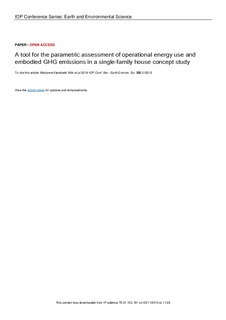| dc.contributor.author | Wiik, Marianne Rose Kjendseth | |
| dc.contributor.author | Lolli, Nicola | |
| dc.contributor.author | Fufa, Selamawit Mamo | |
| dc.date.accessioned | 2019-11-06T06:19:38Z | |
| dc.date.available | 2019-11-06T06:19:38Z | |
| dc.date.created | 2019-11-04T08:28:46Z | |
| dc.date.issued | 2019 | |
| dc.identifier.issn | 1755-1307 | |
| dc.identifier.uri | http://hdl.handle.net/11250/2626757 | |
| dc.description.abstract | Present day European legislation focuses upon the reduction of greenhouse gas (GHG) emissions in buildings through better design and technological solutions, with a view to reduce operational energy use and embodied GHG emissions. Currently, environmental performance assessment tools for buildings lack in assessing these parameters over the entire lifecycle of a building. Life cycle assessment (LCA) is a well-established methodology that gives a clear insight into the potential environmental impacts during the service life of a building. However, architect, engineer and constructor (AEC) professionals consider LCA as complex and time consuming. This paper builds upon a methodology for the development of a parametric analysis tool (PAT), which comprehensively assesses operational energy use and embodied GHG emissions during the lifecycle of a building. In this phase of the PAT's development, the complexity of the tool has been increased by expanding the number of parameters from four (i.e. insulation thickness, window types, North façade glazing area and South façade glazing area) to seven (i.e. climatic zones, solar shading and electricity emission factors). This has increased the amount of parametric permutations from 1,372 to 12,348. The PAT has been applied to a conceptual two-storey single-family house, developed by the Norwegian ZEB Research Centre, which is assumed to be in either Oslo (Norway) or Lecce (Italy). The results show that the choice of insulation thickness influences total energy use less than the selection of shading types or glazing areas. The results also show the parametric selection with the least amount of operational energy use (34kWh/m2/yr) in the Lecce climate consists of triple-glazed windows (0.5W/m2k), 10m2 of glazing on the north façade, 20m2 of glazing on the south facade. The results show the parametric selection with the lowest total GHG emissions in the Oslo climate (7.8kgCO2eq/m2/yr) consists of triple glazing (0.5W/m2k), 10m2 of glazing on the north facade and 20m2 glazing on the south facade. This is because a lower electricity emission factor (132gCO2eq/kWh for Norway and 290gCO2eq/kWh for Italy) was used for converting operational energy use to GHG emissions, even though the Oslo climate has a higher heating demand compared to Lecce. In conclusion, this paper shows how complex design options can be evaluated in a holistic way through PAT to ascertain the best selection of design criteria for low GHG emissions and low operational energy use. | nb_NO |
| dc.language.iso | eng | nb_NO |
| dc.publisher | IOP Publishing Ltd. | nb_NO |
| dc.relation.ispartof | 1st Nordic conference on Zero Emission and Plus Energy Buildings | |
| dc.rights | Attribution-NonCommercial-NoDerivatives 4.0 Internasjonal | * |
| dc.rights.uri | https://creativecommons.org/licenses/by/3.0/ | * |
| dc.title | A tool for the parametric assessment of operational energy use and embodied GHG emissions in a single-family house concept study | nb_NO |
| dc.type | Conference object | nb_NO |
| dc.type | Journal article | nb_NO |
| dc.type | Peer reviewed | nb_NO |
| dc.description.version | publishedVersion | nb_NO |
| dc.rights.holder | © The authors | en |
| dc.subject.nsi | VDP::Teknologi: 500 | nb_NO |
| dc.source.volume | 352 | nb_NO |
| dc.source.journal | IOP Conference Series: Earth and Environmental Science (EES) | en |
| dc.identifier.doi | 10.1088/1755-1315/352/1/012012 | |
| dc.identifier.cristin | 1743646 | |
| dc.relation.project | EC/H2020/754177 | nb_NO |
| cristin.unitcode | 7401,30,20,0 | |
| cristin.unitcode | 7401,30,40,0 | |
| cristin.unitname | Bygninger og installasjoner | |
| cristin.unitname | Arkitektur, byggematerialer og konstruksjoner | |
| cristin.ispublished | true | |
| cristin.fulltext | original | |
| cristin.qualitycode | 1 | |

